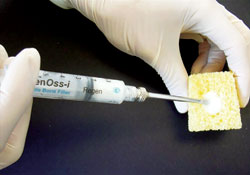Inject bone into the fracture

A researcher demonstrates the power of Injectable Bone - Photo: Discovery
It took a month for the bone to recur even if it was just a small crack. Now, scientists are studying how to make bones faster, by injecting a mixture into a fracture.
Robin Quirk, a professor at Nottingham University (UK), along with Kevin Shakesheff (USA), are the first to develop this technology. According to Mr. Quirk: 'We are trying to make a compound to fill in the space created by fracture, which can act as a normal spongy bone and stimulate bone regeneration naturally' . There is no need to 'cut the flesh', with this compound, all the doctor's tools need is just a needle to bring the powder to where it is needed.
The white powder mentioned above, which looks like toothpaste, is a mixture of ceramic and polylactic acid, named Injectable Bone (meaning 'Bone can be injected'). At room temperature, it is an inert powder. But once inserted into the broken bone with a needle, the body temperature causes the two materials to melt and twist together into a hard and spongy mass like real bone. It is noteworthy that during hardening, Injectable Bone does not radiate heat - which can damage surrounding tissue. According to experts, Injectable Bone can replace bone implants in many cases. Injectable Bone is not intended to replace natural bone permanently, but only gives the body time to recover thanks to its ability to stimulate bone growth.
Many cracks on the same bone may be difficult to heal. To keep the skeleton in place, doctors often install pins and surgical rods that can make patients suffer when removed. Injectable Bone can replace surgical pins that are currently used to help bones. Even so, it does not allow patients to give up . bandages, because the binder is not strong enough to support body weight.
- How to replace broken bone with bone culture method?
- Bone regeneration with magnetic nanoparticles
- Osteoporosis - The disease is silent
- Anti-breast cancer drugs reduce bone density
- The new invention turns fat into bone
- Fast bone speed
- A new way to treat broken bones: Bundle with 3D print material
- Synthes Rib Matrix - new surgical method that helps fracture to recover quickly
- The world's first 3D jaw bone graft surgery
- Connecting bones with silk screws
- What is bone cancer?
- Solder fractured bones in a few minutes
 Green tea cleans teeth better than mouthwash?
Green tea cleans teeth better than mouthwash? Death kiss: This is why you should not let anyone kiss your baby's lips
Death kiss: This is why you should not let anyone kiss your baby's lips What is salmonellosis?
What is salmonellosis? Caution should be exercised when using aloe vera through eating and drinking
Caution should be exercised when using aloe vera through eating and drinking